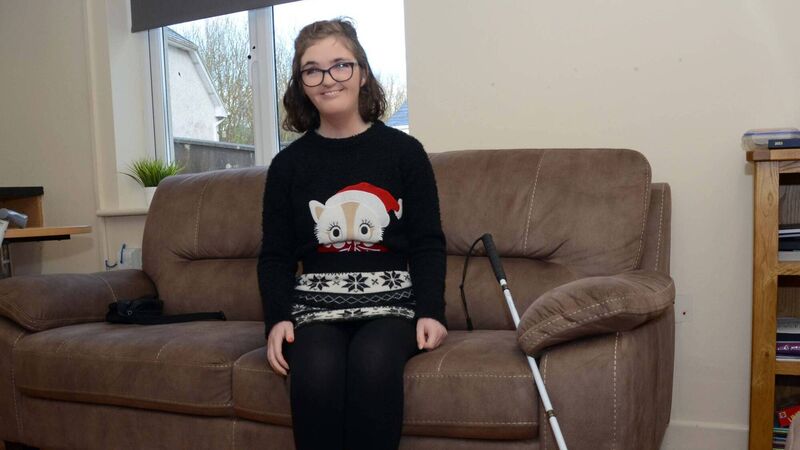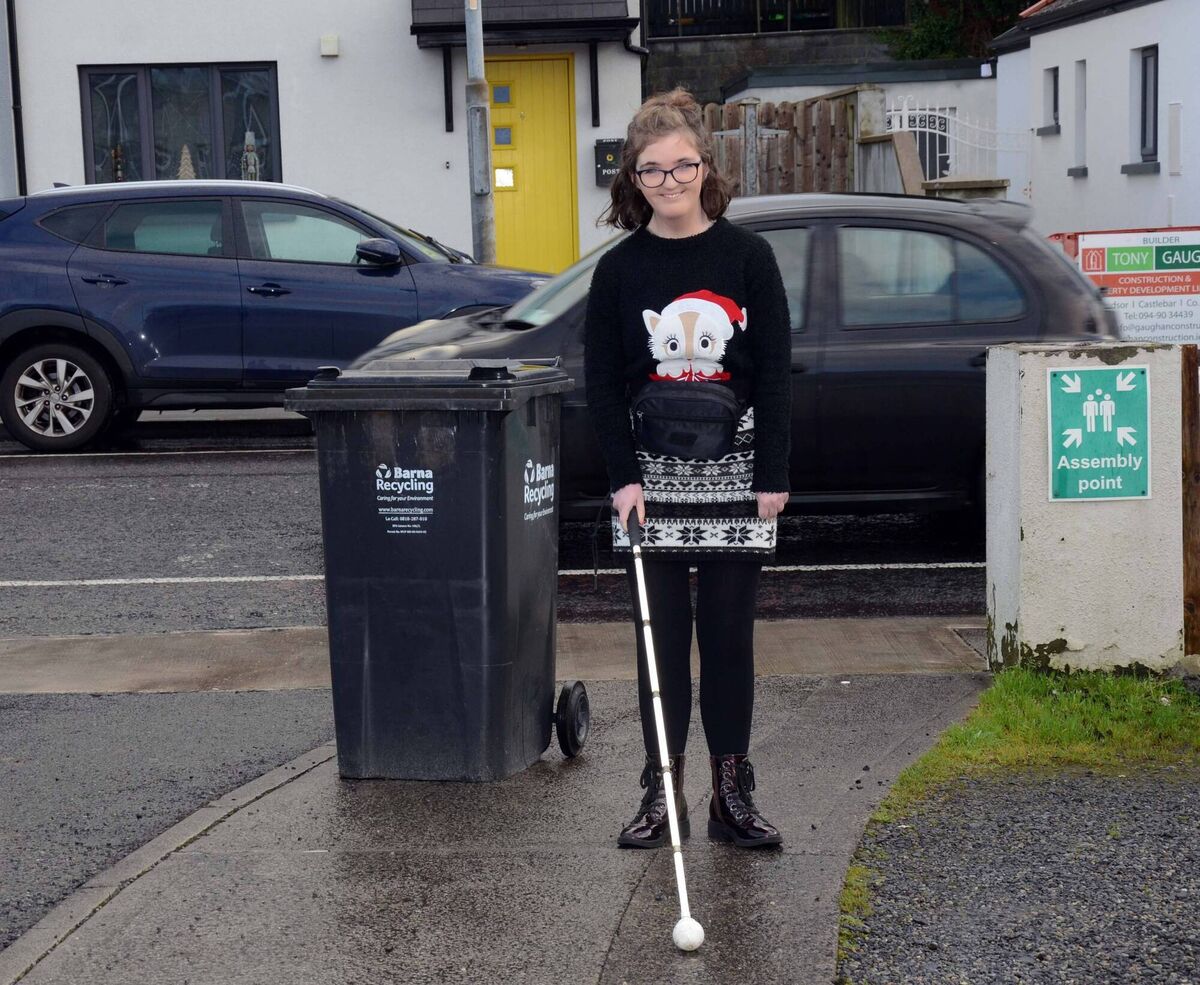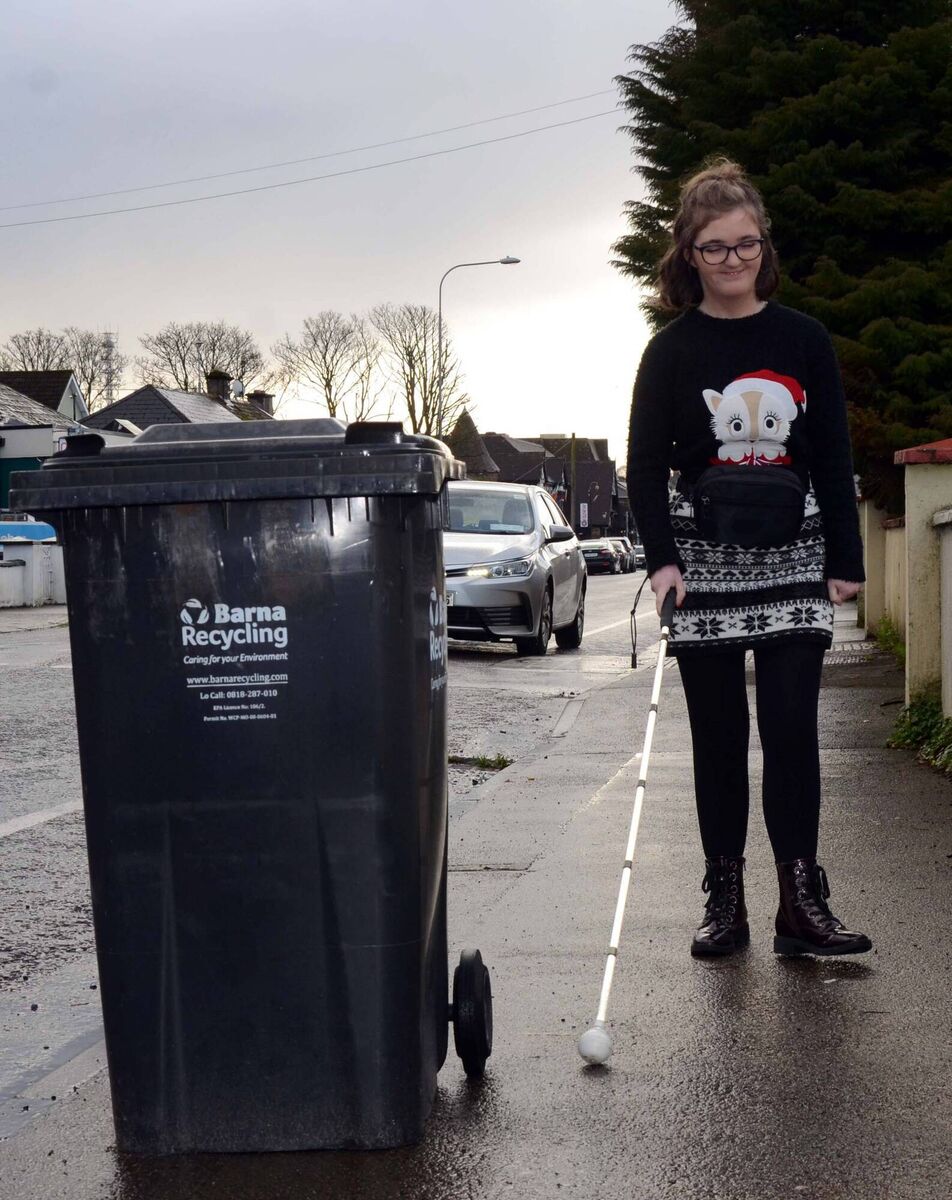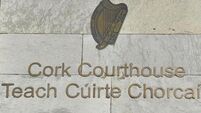Dog foul, badly parked cars and wheelie bins: Getting around is no joke for visually impaired Róisín

Roisin Lenihan at her day care centre in Castlebar Mayo. She is campaigning to clear the footpaths as she learns to walk independently herself. Picture: Paul Mealey
A blind woman who has begun the difficult process of learning to walk on her own has pleaded with the public to keep footpaths clear, to help the visually impaired.
Roisin Lenihan, from Shammer in Kilkelly, Co Mayo was born blind. This year she has started to learn to walk on her own on different routes.
The 22-year-old said this involves walking with the use of a long white cane and a supporting person until she becomes familiar with the route.
However, since she started the process, she has noticed several issues that can cause major problems for people with disabilities.
She has experienced getting her cane stuck in dog foul while wheelie bins, café signs, and street furniture can all block her walk.
“Dog fouling is a huge issue,” she said “Unfortunately, I had my cane stuck in it and a sighted person with me had to tell me.
“On another occasion, I was beside McDonalds in Castlebar where I go to the gym and go swimming, and there was a footpath with trees and branches hanging down and I nearly had to go out on the road — it was very dangerous.
“Every Wednesday I go to Vision Ireland in Drumcondra in Dublin and on my way from the train station to the training centre, the footpaths are so narrow. When it is bin day, people put their bins out in the middle of the footpath”.

Roisin has joined the charity’s 'Clear Our Paths' campaign to help highlight these issues.
The initiative aims to raise awareness about the implications of temporary obstacles for people who are blind or vision impaired.
It encourages the public to act.
The type of obstacles commonly encountered include cars parked on footpaths, dog fouling, wheelie bins in the centre of the path when they could be against the wall, street furniture that is inappropriately placed, and overhead branches.
The campaign was recently recognised at the Road Safety Authority Awards where it won Education Community Initiative of the year.
A survey in August of National Council for the Blind Service users found 40% of respondents had been injured by footpath obstacles.
One person surveyed had sustained a broken ankle because of unexpected street furniture on a footpath.
Another service user said: "There was a car parked on the footpath. I couldn’t pass it on the inside, so I had to go onto the road a little. As I came off the footpath I tripped and went down, spraining my wrist".
Meanwhile a third service user said an object hanging from a truck had hit them in the face.
Kevin Kelly, National Strategic Partnership Manager with Vision Ireland, said they've been running this campaign for around five years.
“We have a lot of issues with cars being parked illegally.
“That can cause an obstruction for anyone who is vision impaired, you have to step off the path where there is oncoming traffic.
“Overhanging branches and dog fouling is also a major problem, it’s particularly difficult and messy for someone to clean the soles of their shoes and cane after walking in dog foul.
“We just want people to be more mindful of these things”.
Roisin said these issues might seem minor to some members of the public but can make a huge difference to her.
“It’s just a matter of thinking before you act and asking yourself could this be a hazard for someone like me who is blind”.
Meanwhile her walking routes are beginning to expand, and she described how she is now exploring new areas.
“I am walking from Castlebar Resource Centre in Co. Mayo to the Ivy Tower Hotel so far, which is down the street from the day care service” said Róisín.
“I only started walking on my own this year it only took me around three months to learn the route.
“I am able to do that route independently now. Up until this year, one of the staff members would be walking with me and I’d have to hold onto their elbow.”
All her life the young woman has depended on someone to walk with her, but the older she gets the more she wants to be independent.
She is walking at least once a week on her own now. “I am not so nervous now” she said. “I go along that route and there is a small shop so I can go and get milk for the daycare centre.
“We have moved onto another route — from the day service in Castlebar to the petrol station up the road. If I need to go and get lunch someday, I can do that, and don’t need anyone with me.
“With Vision Ireland, I will be learning the route to NCBI, where their training centre is on the Whitworth Road.
“I get the train to Dublin every Wednesday on my own and one of the staff there meets me, and they are going to teach me the route to the training centre. Irish Rail also have someone to help me get on and off the train.
Roisin said while she would love a guide dog, training for that is a much more difficult process.
“You need to have very good cane skills and you need to know where you’re going” she said. “You can’t ask the dog where you are going, they don’t know, you lead them, and they help you. I am not ready for that yet”, she said.
A total of 296,601 Irish people — about 6% of the population — have experienced blindness or a vision impairment to any extent, according to Vision Ireland's latest figures.
It represents an increase from the 2016 census, which reported 54,810 people in Ireland who were blind or vision impaired.
The figures also show that 30,965 people experience blindness or a vision impairment to a great extent, and 265,636 experience blindness or a vision impairment to some extent.
The incidence of blindness or a vision impairment experienced to a great extent increases with age.
The highest incidence of blindness or a vision impairment was recorded in the over 85s, with significantly more females than males experiencing this condition.
And the condition can be extremely limiting, with 65,099 people who are blind or visually impaired reporting difficulty going outside the home and 63,113 people experiencing blindness or a vision impairment having difficulty working or attending school or college.
Roisin, who is the youngest of five children, was born blind and there are no other cases in her family.
“I was born with aniridia and glaucoma,” she said.
“Aniridia is a very rare thing. It’s even more rare with glaucoma. The doctors saw it straight away, I have no iris basically.
“My consultant recommended an operation in a hospital unit in Rochester upstate New York when I was six-years-old.
“When I was little, I had a detached retina in the left eye and there was nothing they could do to save it.
“I had an artificial cornea put into my right eye. That brought my vision up to 10% for four years in the right eye.
“I could tell you when we drove past a petrol station and church and I knew my colours.
“I was six-years-old, and it lasted until I was 10.
“The back of the eye started acting up and that was that, it didn’t work out”.
She underwent three operations to flatten out the retina in her eye which were sadly unsuccessful overall.
“In 2013, I lost my vison, and I lost my colours,” said Roisin. “It was disappointing but to be honest I don’t think about it much anymore.”
She went to school in Co Mayo and did the Applied Leaving Cert at 19, before linking in with the Disability Federation of Ireland, where she recently completed a media training programme.
“It was a six week course, and I did some of it online and then I chose to go up in person for the rest of it.
“I enjoyed it as it helped teach us a lot about the media and fact checking and being comfortable doing an interview. The DFI is very supportive”.
Along with her campaign to keep paths clear as well as media training, Roisin is also highlighting a number of improvements she would like to see with Irish Rail.
“I have a good relationship with Irish Rail” she said. “They will have someone meet me off at the train station to help me on and off.
“But we could go further, for example, when you book a priority train ticket online for a person with disabilities like me, you can’t get a second seat for someone going with you.
“From Dublin to Cork you can book more than one disability seat online, but on every other train in Ireland you can’t.
“I’d like to see that change. Also, I’d like to see the yellow lines at the stations being managed better. The ones in Drumcondra are faded and you need to feel them with your cane, so you know you’ve gone far enough on the platform, it’s a safety issue”.
She also hopes to eventually gain full time employment when she learns to become more independent.
“I’d love a job in Knock airport” she said. “I love it there, as part of my Leaving Cert Applied, I did work experience one day a week, for 10 weeks.

Responding to queries from the on the issue of obstructed footpaths, the Department of Housing said footpaths are managed by local authorities.
“They are intended to provide a safe place for pedestrians and should be kept clear of obstructions. Street furniture requires a licence from the local authority and must be placed in such a way to minimise obstruction," said the department's statement.
“As well as taking relevant enforcement action against footpath obstruction, including parking enforcement, local authorities engage in awareness campaigns to highlight the difficulties caused by blocked footpaths, including the annual MakeWayDay campaign run by the Disability Federation of Ireland.
"Local authorities also run campaigns to encourage the public to pick up after their dogs and highlight the impacts that dog fouling has, particularly for those with disabilities, wheelchair users, people with visual impairments and those using buggies."
Accessibility challenges are the responsibility of numerous Government departments, local authorities and public bodies depending on their remit, and should be managed according to the principle of Universal Design.
This is defined in Article 2 of the UN Convention on the Rights of Persons with Disabilities as the “design of products, environments, programmes and services to be usable by all people, to the greatest extent possible, without the need for adaptation or specialised design”.
The National Disability Authority provides guidance to government and to public bodies on a range of disability issues, including Universal Design, and has produced a Code of Practice on Accessibility of Public Services and Information Provided by Public Bodies.
According to the Department of Children, Equality, Integration, Disability and Youth, work is currently underway for developing the next National Disability Strategy, which will fulfil a Programme for Government commitment to develop the next whole-of-government strategy for implementing Ireland’s commitments under the UNCRPD.
Members of the public can have their say on https://www.gov.ie/en/publication/c223d-upcoming-consultation-have-your-say/ . This year the department will also carry out targeted virtual focus groups, opportunities to provide written and video submissions, contributions to a national survey, and attendance at a series of in-person town-hall style meetings in early 2024.
Irish Rail did not respond to queries from the Irish Examiner around Ms Lenihan’s concerns.
Mayo County Council said that each municipal district deals with the issue of blocked footpaths at a local level.
Claremorris Swinford MD said area engineers deal with specific issues when matters are brought to its attention. Ballina MD produced a report relating to the street walkability of the area. In Westport Belmullet, traders are asked to keep footpaths clear, except for licenced outdoor furniture, and follow up checks are undertaken, with "offending obstacles" removed from footpaths.
Castlebar does not have specific initiatives relating to street clutter, but noted several bodies, including the traffic warden, undertake regular checks and issue fines where appropriate.












